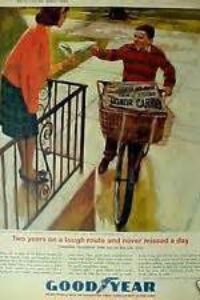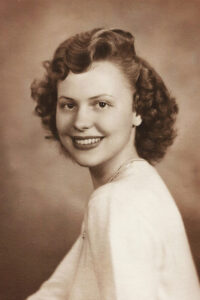I was home on a Christmas break from Pepperdine University in 1973 and my father was taking me and my younger brothers on the Virgin Falls hike. A mutual friend who lived in the area had taken them on the hike a few months earlier and Dad and my brothers couldn’t wait to share the experience with me. “It’s like nothing you’ve ever seen,” they all kept saying as we drove the three hours from our Nashville home to the trailhead in eastern Tennessee. “They can’t find the source of the waterfall. It comes out of a cave on the top of this big hill, drops over a hundred feet and disappears. No one knows where it comes from and where it goes.” That, along with the promise of exploring deep caverns, climbing boulders, and being taught by my brothers how to “ride down trees,” raised my expectation for adventure.
It was like walking into a primeval forest. For the first mile the trail meandered along a creek through spacious groves of indigenous tree varieties before it began a steep decline beneath thick canopies of mountain laurel until trail and creek converged into a large stream. We had to forge the wide stream hopping from rock to rock that rose out of the churning water in random patterns. While not life-threatening, a misstep meant wet boots and clothes for the next eight miles, and since it happened to be winter, that would add to the misery and ridicule from my brothers. The unofficial Arnold gauntlet was to see who could use the least number of rocks to get from one bank to the other. This crossing was probably twenty feet wide and the water flow was high, which meant there was minimal rock exposure to use as a landing and launching platform through the swift current. It required thrust and agility to leap across the stream bounding from rock to rock. Dad went first, pathfinder that he was, and my brothers and I followed. I don’t remember who won; I just remember marveling at dad’s ability to leap from rock to rock with a dancer’s grace and then the joy he took in watching his sons follow after him. Long gone were the days of having to hold our hands through precarious crossings of any kind. We all had been set free to stand or fall on our own; the momentum of manhood.
We followed the stream for another mile and a half; it’s steady and gradual descent a deception we would come to see as a liability on our return trip. The footpath remained narrow, but the course of the stream would expand or contract as dictated by the contours of the landscape rushing around large boulders, tumbling into small waterfalls, or cascading down a natural rock slide into deep pools that during summer hikes afforded us opportunities to refresh our sweaty bodies with a dip in nothing but Adam’s original suit.
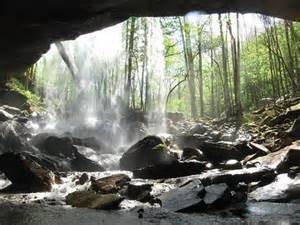 At the halfway point we came upon this great cavern in the shape of a giant’s mouth full-open; an outcropping of rocks forming a misshapen jaw line and jagged teeth while the upper lip was smooth and curved by the eroding flow of the stream we had followed. At this point the water dropped fifty feet splashing onto the rocks below before disappearing into the giant’s gullet. The opening was so wide we could make our way around the falls and deep inside the great chasm. We had stepped into Jules Verne’s adventure story, “Journey to the Center of the Earth,” and at any moment I expected prehistoric creatures to emerge out of the immense, dank walls.
At the halfway point we came upon this great cavern in the shape of a giant’s mouth full-open; an outcropping of rocks forming a misshapen jaw line and jagged teeth while the upper lip was smooth and curved by the eroding flow of the stream we had followed. At this point the water dropped fifty feet splashing onto the rocks below before disappearing into the giant’s gullet. The opening was so wide we could make our way around the falls and deep inside the great chasm. We had stepped into Jules Verne’s adventure story, “Journey to the Center of the Earth,” and at any moment I expected prehistoric creatures to emerge out of the immense, dank walls.
After a brief rest we trekked on until we came to a boulder field and next to it was a stand of young sapling trees that fought for survival against boulders crowding in on one side and old-growth trees on the other. My two younger brothers scampered up the side of the boulder excited to educate me in the art of riding down a tree. They hurled their bodies at young saplings, and then rode down their tree as it awkwardly bent double to deposit the passenger onto the ground. This was all the instruction I needed, and I followed their example while Dad chose to keep his feet firmly planted on the land taking pride and pleasure in watching his sons leap into the tops of the nimble trees in our attempt to test Darwin’s theory of evolution.
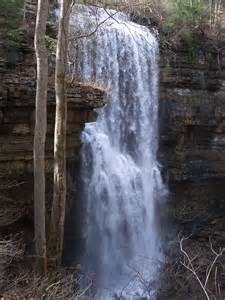 After collecting a few scratches to the face and a rip or two on our shirts and jeans from the branches that fought against being manhandled, we journeyed down the trail. Within a quarter mile of the falls I heard the relentless rumble of water pounding the earth. The only trail access to the falls was from the southeast side of the hill so as we rounded the bend my first sight of the falling water was in profile. It was as if we walked into a crater with the south side rim missing. There was a loop trail that went around the rim to the cave at the top of the hill where the water flowed out. The trail then continued on until it dissolved onto the top of a cliff wall that dropped down to our original starting point. The cliff was treacherous, but still scaleable to the nervy rock climber.
After collecting a few scratches to the face and a rip or two on our shirts and jeans from the branches that fought against being manhandled, we journeyed down the trail. Within a quarter mile of the falls I heard the relentless rumble of water pounding the earth. The only trail access to the falls was from the southeast side of the hill so as we rounded the bend my first sight of the falling water was in profile. It was as if we walked into a crater with the south side rim missing. There was a loop trail that went around the rim to the cave at the top of the hill where the water flowed out. The trail then continued on until it dissolved onto the top of a cliff wall that dropped down to our original starting point. The cliff was treacherous, but still scaleable to the nervy rock climber.
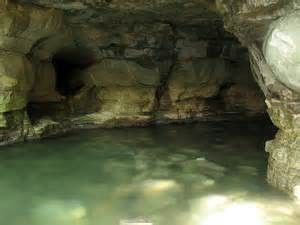 Dad and my brothers told the truth: the water did come out of a cave; it did drop over a hundred feet and disappear into the dark, saturated earth; it had no visible source, no headwaters, no obvious current feeding into another body of water. Local scientists had attempted to discover its source by exploring the cave until it became impassable and searched for the waters’ destination point by dropping tracking devices into the hole at the bottom of the falls, but to no avail. So mythology took over and it was named Virgin Falls for its mysterious, subterranean, circulatory system with no beginning and no end.
Dad and my brothers told the truth: the water did come out of a cave; it did drop over a hundred feet and disappear into the dark, saturated earth; it had no visible source, no headwaters, no obvious current feeding into another body of water. Local scientists had attempted to discover its source by exploring the cave until it became impassable and searched for the waters’ destination point by dropping tracking devices into the hole at the bottom of the falls, but to no avail. So mythology took over and it was named Virgin Falls for its mysterious, subterranean, circulatory system with no beginning and no end.
There were several hikes between that first time and the last one my brothers and I took with our father. Dad was nearing seventy by this time, gone through a couple of pacemakers, and yet was still honorably resistant to the encroachment of age. While the stream that had to be forged in the first stage of the hike was now made easier by a cable and strung over the rushing waters attached from one tree to another, the mile and a half ascent from the cavern to level ground in the last stage was more difficult. Dad needed to stop every thirty or forty yards to catch his breath. A couple of times I felt impatient, my legs eager to keep a pace that was impossible for Dad to maintain. I wish I could have those seconds back, reframe them with a more positive sentiment instead of the baser one I felt. I wonder now if he might have been milking the time just for the few extra minutes with his sons. At one of those “rest stops” along the trail he seemed to acknowledge his mortality when he said, “This might be my last time here, boys.” It was, but he expressed it in such a way that revealed his true nature as the eternal optimist.
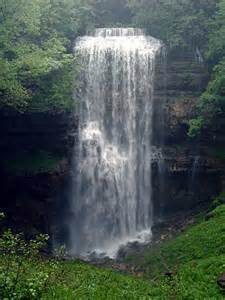 I have hiked on trails all over the world, many of them more stunning in beauty than Virgin Falls, but like a first love, there will always be something special about that hike that can never be surpassed. I saw Dad in a new light on that hike: a father’s joy at sharing with his sons the wonder, the mystery, and the beauty of a small part of our planet. I have taken this trail with Kay and my daughters, and then with their husbands who are now my sons. In a few years, I expect to show my grandchildren the incredible sights and sounds of Virgin Falls, and they too might get impatient with their grandfather when he has to stop to rest with more frequency. And someday I expect to say, “This might be my last time here.” But not anytime soon. My final trek will be a one-way trip. I will be carried in, my ashes in a box, and then scattered at the mouth of the cave to become part of the unfathomable, eternal flow of Virgin Falls.
I have hiked on trails all over the world, many of them more stunning in beauty than Virgin Falls, but like a first love, there will always be something special about that hike that can never be surpassed. I saw Dad in a new light on that hike: a father’s joy at sharing with his sons the wonder, the mystery, and the beauty of a small part of our planet. I have taken this trail with Kay and my daughters, and then with their husbands who are now my sons. In a few years, I expect to show my grandchildren the incredible sights and sounds of Virgin Falls, and they too might get impatient with their grandfather when he has to stop to rest with more frequency. And someday I expect to say, “This might be my last time here.” But not anytime soon. My final trek will be a one-way trip. I will be carried in, my ashes in a box, and then scattered at the mouth of the cave to become part of the unfathomable, eternal flow of Virgin Falls.



